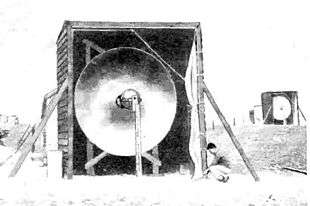Barkhausen–Kurz tube



The Barkhausen–Kurz tube, also called the retarding-field tube, reflex triode, B–K oscillator, and Barkhausen oscillator was a high frequency vacuum tube electronic oscillator invented in 1920 by German physicists Heinrich Georg Barkhausen and Karl Kurz.[1][2] It was the first oscillator that could produce radio power in the ultra-high frequency (UHF) portion of the radio spectrum, above 300 MHz. It was also the first oscillator to exploit electron transit time effects.[1] It was used as a source of high frequency radio waves in research laboratories, and in a few UHF radio transmitters through World War 2. Its output power was low which limited its applications. However it inspired research that led to other more successful transit time tubes such as the klystron.
History
After the development by Lee de Forest of the triode vacuum tube in 1906, it was realized that the upper frequency at which the device could be used was limited by the spacing between internal components. Even with the smallest of spacing, the frequency limit of early triodes was in the low megahertz range. A technique called velocity modulation was theorized to overcome this limitation.
In 1920, Heinrich Barkhausen and Karl Kurz at the Technische Hochschule in Dresden, Germany used the velocity modulation theory in developing a "retarded-field" triode. They found it could operate at frequencies into the UHF region, the first vacuum tube to do so. Although severely limited in output power, the Barkhausen–Kurz tube was quickly adopted world-wide for UHF research. This device is also called the retarded-field and positive-grid oscillator. Versions of the Barkhausen oscillator were used in some of the first applications of microwaves, such as the first microwave relay system, a 1.7 GHz link across the English Channel in 1931,[3] and in early radar systems used in World War 2.
The success of the Barkhausen-Kurz tube in generating power at microwave frequencies inspired research to develop similar tubes which did not have its limitations, resulting in the invention of other tubes which were known as "reflex oscillators". The best known result of this research was the klystron tube[4][5] invented 1937 by Russell and Sigurd Varian. Sources like the klystron and magnetron replaced the B-K tube around World War 2 and it became obsolete.
How it works

The Barkhausen–Kurz tube was a triode operated with the grid (a thin mesh of wires) at a positive potential relative to both the cathode (or filament) and the anode (or plate). The negative electrons emitted from the cathode are accelerated toward the positive grid. Most pass between the grid wires and approach the anode. The low potential anode repels the electrons and they reverse direction before they hit the plate. They are then accelerated back toward the grid which is more positive than the anode plate, again pass through the grid wires, and are then repelled by the negative cathode, their direction reversing just before reaching the surface. The electrons continue oscillating back and forth through the grid until one by one they strike the grid wires.
The oscillating potential induced on the grid by the motion of the electrons excites oscillations in a tank circuit attached to the grid, usually consisting of a quarter wavelength of parallel transmission line shorted at the end, called a resonant stub. In turn the oscillating voltage on the tank circuit causes the electrons to bunch into a cloud of electrons moving back and forth through the grid in phase.
This oscillatory motion of the electron cloud continues, with some electrons lost to grid on each pass constituting the output current. The lost electrons are replenished by new electrons emitted by the cathode. The frequency of oscillation depends on the spacing and potentials of the electrodes, and can be changed to a limited extent by altering the electrode voltages. [6] The space charge density is low and so unlike in a conventional triode oscillator the AC plate and grid current is small, so the output power of the B-K oscillator is low.
References
- 1 2 Thumm, Manfred (2011). "Heinrich Barkhausen: First transit-time microwave tube" (PDF). Historical German contributions to physics and applications of electromagnetic oscillations and waves. Electron Device Society, Institute of Electrical and Electronic Engineers (IEEE). Retrieved March 30, 2013.
- ↑ Petersen, J.K. (2002). Fiber Optics Illustrated Dictionary. CRC Press. p. 103. ISBN 084931349X.
- ↑ Free, E. E. (August 1931). "Searchlight radio with the new 7 inch waves" (PDF). Radio News. New York: Radio Science Publications. 8 (2): 107–109. Retrieved March 24, 2015.
- ↑ Faragő, P. S., and G. Groma, "Reflex oscillators", Acta physica Academiae Scientiarum Hungaricae, Vol. 4, No. 1, August, 1954, pp. 7–22
- ↑ Klinger, Hans Herbert, Applications of Microwaves in Scientific Research, Elsevier, 1953
- ↑ Alfvén, Hannes, “On the theory of the barkhausen-kurz oscillations,” Philosophical Magazine Series 7, Vol. 19, February, 1935, pp. 419–422
External links
- Potapenko, G. (1932-02-13). "Investigations in the field of ultra-short electromagnetic waves" (PDF). Phys Rev. 39: 625–638.